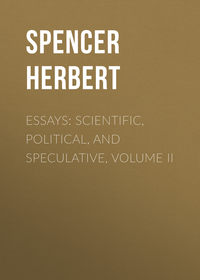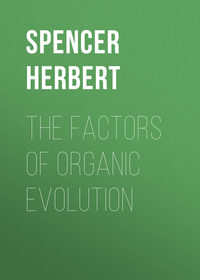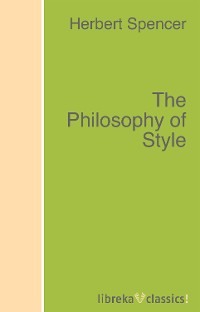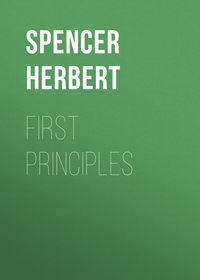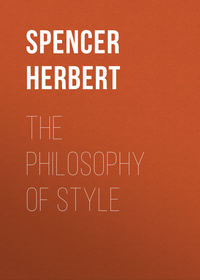 полная версия
полная версияThe Principles of Biology, Volume 1 (of 2)
Comparisons of these deductions with the facts appear in some cases to verify them and in other cases not to do so. Throughout the vegetal kingdom, there are no distinct limits to growth except those which death entails. Passing over a large proportion of plants which never exceed a comparatively small size, because they wholly or partially die down at the end of the year, and looking only at trees that annually send forth new shoots, even when their trunks are hollowed by decay; we may ask – How does growth happen here to be unlimited? The answer is, that plants are only accumulators: they are in no very appreciable degree expenders. As they do not undergo waste there is no reason why their growth should be arrested by the equilibration of assimilation and waste. Again, among animals there are sufficient reasons why the correspondence cannot be more than approximate. Besides the fact above noted, that there are other varying relations which complicate the chief one. We must bear in mind that the bodies compared are not truly similar: the proportions of trunk to limbs and trunk to head, vary considerably. The comparison is still more seriously vitiated by the inconstant ratio between the constituents of which the body is composed. In the flesh of adult mammalia, water forms from 68 to 71 per cent., organic substance from 24 to 28 per cent., and inorganic substance from 3 to 5 per cent.; whereas in the fœtal state, the water amounts to 87 per cent., and the solid organic constituents to only 11 per cent. Clearly this change from a state in which the force-evolving matter forms one-tenth of the whole, to a state in which it forms two and a half tenths, must greatly interfere with the parallelism between the actual and the theoretical progression. Yet another difficulty may come under notice. The crocodile is said to grow as long as it lives; and there appears reason to think that some predaceous fishes, such as the pike, do the same. That these animals of comparatively high organization have no definite limits of growth, is, however, an exceptional fact due to the exceptional non-fulfilment of those conditions which entail limitation. What kind of life does a crocodile lead? It is a cold-blooded, or almost cold-blooded, creature; that is, it expends very little for the maintenance of heat. It is habitually inert: not usually chasing prey but lying in wait for it; and undergoes considerable exertion only during its occasional brief contests with prey. Such other exertion as is, at intervals, needful for moving from place to place, is rendered small by the small difference between the animal's specific gravity and that of water. Thus the crocodile expends in muscular action an amount of force that is insignificant compared with the force commonly expended by land-animals. Hence its habitual assimilation is diminished much less than usual by habitual waste; and beginning with an excessive disproportion between the two, it is quite possible for the one never quite to lose its advance over the other while life continues. On looking closer into such cases as this and that of the pike, which is similarly cold-blooded, similarly lies in wait, and is similarly able to obtain larger and larger kinds of prey as it increases in size; we discover a further reason for this absence of a definite limit. To overcome gravitative force the creature has not to expend a muscular power that is large at the outset, and increases as the cubes of its dimensions: its dense medium supports it. The exceptional continuance of growth observed in creatures so circumstanced, is therefore perfectly explicable.
§ 46a. If we go back upon the conclusions set forth in the preceding section, we find that from some of them may be drawn instructive corollaries respecting the limiting sizes of creatures inhabiting different media. More especially I refer to those varying proportions between mass and stress from which, as we have seen, there results, along with increasing size, a diminishing power of mechanical self-support: a relation illustrated in its simplest form by the contrast between a dew-drop, which can retain its spheroidal form, and the spread-out mass of water which results when many dew-drops run together. The largest bird that flies (the argument excludes birds which do not fly) is the Condor, which reaches a weight of from 30 to 40 lbs. Why does there not exist a bird of the size of an elephant? Supposing its habits to be carnivorous, it would have many advantages in obtaining prey: mammals would be at its mercy. Evidently the reason is one which has been pointed out – the reason that while the weight to be raised and kept in the air by a bird increases as the cubes of its dimensions, the ability of its bones and muscles to resist the strains which flight necessitates, increases only as the squares of the dimensions. Though, could the muscles withstand any tensile strain they were subject to, the power like the weight might increase with the cubes, yet since the texture of muscle is such that beyond a certain strain it tears, it results that there is soon reached a size at which flight becomes impossible: the structures must give way. In a preceding paragraph the limit to the size of flying creatures was ascribed to the greater physiological cost of the energy required; but it seems probable that the mechanical obstacle here pointed out has a larger share in determining the limit.
In a kindred manner there results a limitation of growth in a land-animal, which does not exist for an animal living in the water. If, after comparing the agile movements of a dog with those of a cow, the great weight of which obviously prevents agility; or if, after observing the swaying flesh of an elephant as it walks along, we consider what would happen could there be formed a land-animal equal in mass to the whale (the long Dinosaurs were not proportionately massive) it needs no argument to show that such a creature could not stand, much less move about. But in the water the strain put upon its structures by the weights of its various parts is almost if not quite taken away. Probably limitation in the quantity of food obtainable becomes now the chief, if not the sole, restraint.
And here we may note, before leaving the topic, something like a converse influence which comes into play among creatures inhabiting the water. Up to the point at which muscles tear from over-strain, larger and smaller creatures otherwise alike, remain upon a par in respect of the relative amounts of energy they can evolve. Had they to encounter no resistance from their medium, the implication would be that neither would have an advantage over the other in respect of speed. But resistance of the medium comes into play; and this, other things equal, gives to the larger creature an advantage. It has been found, experimentally, that the forces to be overcome by vessels moving through the water, built as they are with immersed hinder parts which taper as fish taper, are mainly due to what is called "skin-friction." Now in two fish unlike in size but otherwise similar skin-friction bears to the energy that can be generated, a smaller proportion in the larger than in the smaller; and the larger can therefore acquire a greater velocity. Hence the reason why large fish, such as the shark, become possible. In a habitat where there is no ambush (save in exceptional cases like that of the Lophius or Angler) everything depends on speed; and if, other things equal, a larger fish had no mechanical advantage over a smaller, a larger fish could not exist – could not catch the requisite amount of prey.
§ 47. Obviously this antagonism between accumulation and expenditure, must be a leading cause of the contrasts in size between allied organisms that are in many respects similarly conditioned. The life followed by each kind of animal is one involving a certain average amount of exertion for the obtainment of a given amount of nutriment – an exertion, part of which goes to the gathering or catching of food, part to the tearing and mastication of it, and part to the after-processes requisite for separating the nutritive molecules – an exertion which therefore varies according as the food is abundant or scarce, fixed or moving, according as it is mechanically easy or difficult to deal with when secured, and according as it is, or is not, readily soluble. Hence, while among animals of the same species having the same mode of life, there will be a tolerably constant ratio between accumulation and expenditure, and therefore a tolerably constant limit of growth, there is every reason to expect that different species, following different modes of life, will have unlike ratios between accumulation and expenditure, and therefore unlike limits of growth.
Though the facts as inductively established, show a general harmony with this deduction, we cannot usually trace it in any specific way; since the conflicting and conspiring factors which affect growth are so numerous.
§ 48. One of the chief causes, if not the chief cause, of the differences between the sizes of organisms, has yet to be considered. We are introduced to it by pushing the above inquiry a little further. Small animals have been shown to possess an advantage over large ones in the greater ratio which, other things equal, assimilation bears to expenditure; and we have seen that hence small animals in becoming large ones, gradually lose that surplus of assimilative power which they had, and eventually cannot assimilate more than is required to balance waste. But how come these animals while young and small to have surplus assimilative powers? Have all animals equal surpluses of assimilative powers? And if not, how far do differences between the surpluses determine differences between the limits of growth? We shall find, in the answers to these questions, the interpretation of many marked contrasts in growth that are not due to any of the causes above assigned. For example, an ox immensely exceeds a sheep in mass. Yet the two live from generation to generation in the same fields, eat the same grass, obtain these aliments with the same small expenditure of energy, and differ scarcely at all in their degrees of organization. Whence arises, then, their striking unlikeness of bulk?
We noted when studying the phenomena of growth inductively, that organisms of the larger and higher types commence their separate existences as masses of organic matter having tolerable magnitudes. Speaking generally, we saw that throughout each organic sub-kingdom the acquirement of great bulk occurs only where the incipient bulk and organization are considerable; and that they are the more considerable in proportion to the complexity of the life which the organism is to lead.
The deductive interpretation of this induction may best be commenced by an analogy. A street orange-vendor makes but a trifling profit on each transaction; and unless more than ordinarily fortunate, he is unable to realize during the day a larger amount than will meet his wants; leaving him to start on the morrow in the same condition as before. The trade of the huxter in ounces of tea and half-pounds of sugar, is one similarly entailing much labour for small returns. Beginning with a capital of a few pounds, he cannot have a shop large enough, or goods sufficiently abundant and various, to permit an extensive business. He must be content with the half-pence and pence which he makes by little sales to poor people; and if, avoiding bad debts, he is able by strict economy to accumulate anything, it can be but a trifle. A large retail trader is obliged to lay out much money in fitting up an adequate establishment; he must invest a still greater sum in stock; and he must have a further floating capital to meet the charges that fall due before his returns come in. Setting out, however, with means enough for these purposes, he is able to make many and large sales; and so to get greater and more numerous increments of profit. Similarly, to get returns in thousands merchants and manufacturers must make their investments in tens of thousands. In brief, the rate at which a man's wealth accumulates is measured by the surplus of income over expenditure; and this, save in exceptionably favourable cases, is determined by the capital with which he begins business. Now applying the analogy, we may trace in the transactions of an organism, the same three ultimate elements. There is the expenditure required for the obtainment and digestion of food; there is the gross return in the shape of nutriment assimilated or fit for assimilation; and there is the difference between this gross return of nutriment and the nutriment that was used up in the labour of securing it – a difference which may be a profit or a loss. Clearly, however, a surplus implies that the force expended is less than the force latent in the assimilated food. Clearly, too, the increment of growth is limited to the amount of this surplus of income over expenditure; so that large growth implies both that the excess of nutrition over waste shall be relatively considerable, and that the waste and nutrition shall be on extensive scales. And clearly, the ability of an organism to expend largely and assimilate largely, so as to make a large surplus, presupposes a large physiological capital in the shape of organic matter more or less developed in its structural arrangements.
Throughout the vegetal kingdom, the illustrations of this truth are not conspicuous and regular: the obvious reason being that since plants are accumulators and in so small a degree expenders, the premises of the above argument are but very partially fulfilled. The food of plants (excepting Fungi and certain parasites) being in great measure the same for all, and bathing all so that it can be absorbed without effort, their vital processes result almost entirely in profit. Once fairly rooted in a fit place, a plant may thus from the outset add a very large proportion of its entire returns to capital; and may soon be able to carry on its processes on a large scale, though it does not at first do so. When, however, plants are expenders, namely, during their germination and first stages of growth, their degrees of growth are determined by their amounts of vital capital. It is because the young tree commences life with a ready-formed embryo and store of food sufficient to last for some time, that it is enabled to strike root and lift its head above the surrounding herbage. Throughout the animal kingdom, however, the necessity of this relation is everywhere obvious. The small carnivore preying on small herbivores, can increase in size only by small increments: its organization unfitting it to digest larger creatures, even if it can kill them, it cannot profit by amounts of nutriment exceeding a narrow limit; and its possible increments of growth being small to set out with, and rapidly decreasing, must come to an end before any considerable size is attained. Manifestly the young lion, born of tolerable bulk, suckled until much bigger, and fed until half-grown, is enabled by the power and organization which he thus gets gratis, to catch and kill animals big enough to give him the supply of nutriment needed to meet his large expenditure and yet leave a large surplus for growth. Thus, then, is explained the above-named contrast between the ox and the sheep. A calf and a lamb commence their physiological transactions on widely different scales; their first increments of growth are similarly contrasted in their amounts; and the two diminishing series of such increments end at similarly-contrasted limits.
§ 49. Such are the several conditions by which the phenomena of growth are determined. Conspiring and conflicting in endless unlike ways and degrees, they in every case qualify more or less differently each other's effects. Hence it happens that we are obliged to state each generalization as true on the average, or to make the proviso – other things equal.
Understood in this qualified form, our conclusions are these. First, that growth being an integration with the organism of such environing matters as are of like natures with the matters composing the organism, its growth is dependent on the available supply of them. Second, that the available supply of assimilable matter being the same, and other conditions not dissimilar, the degree of growth varies according to the surplus of nutrition over expenditure – a generalization which is illustrated in some of the broader contrasts between different divisions of organisms. Third, that in the same organism the surplus of nutrition over expenditure differs at different stages; and that growth is unlimited or has a definite limit, according as the surplus does or does not rapidly decrease. This proposition we found exemplified by the almost unceasing growth of organisms that expend relatively little energy; and by the definitely limited growth of organisms that expend much energy. Fourth, that among organisms which are large expenders of force, the size ultimately attained is, other things equal, determined by the initial size: in proof of which conclusion we have abundant facts, as well as the a priori necessity that the sum-totals of analogous diminishing series, must depend upon the amounts of their initial terms. Fifth, that where the likeness of other circumstances permits a comparison, the possible extent of growth depends on the degree of organization; an inference testified to by the larger forms among the various divisions and sub-divisions of organisms.
CHAPTER II.
DEVELOPMENT.19
§ 50. Certain general aspects of Development may be studied apart from any examination of internal structures. These fundamental contrasts between the modes of arrangement of parts, originating, as they do, the leading external distinctions among the various forms of organization, will be best dealt with at the outset. If all organisms have arisen by Evolution, it is of course not to be expected that such several modes of development can be absolutely demarcated: we are sure to find them united by transitional modes. But premising that a classification of modes can but approximately represent the facts, we shall find our general conceptions of Development aided by one.
Development is primarily central. All organic forms of which the entire history is known, set out with a symmetrical arrangement of parts round a centre. In organisms of the lowest grade no other mode of arrangement is ever definitely established; and in the highest organisms central development, though subordinate to another mode of development, continues to be habitually shown in the changes of minute structure. Let us glance at these propositions in the concrete. Practically every plant and every animal in its earliest stage is a portion of protoplasm, in the great majority of cases approximately spherical but sometimes elongated, containing a rounded body consisting of specially modified protoplasm, which is called a nucleus; and the first changes that occur in the germ thus constituted, are changes that take place in this nucleus, followed by changes round the centres produced by division of this original centre. From this type of structure, the simplest organisms do not depart; or depart in no definite or conspicuous ways. Among plants, many of the simplest Algæ and Fungi permanently maintain such a central distribution; while among animals it is permanently maintained by creatures like the Gregarina, and in a different manner by the Amœba, Actinophrys, and their allies: the irregularities which are many and great do not destroy this general relation of parts. In larger organisms, made up chiefly of units that are analogous to these simplest organisms, the formation of units ever continues to take place round nuclei; though usually the nuclei soon cease to be centrally placed.
Central development may be distinguished into unicentral and multicentral; according as the product of the original germ develops more or less symmetrically round one centre, or develops without subordination to one centre – develops, that is, in subordination to many centres. Unicentral development, as displayed not in the formation of single cells but in the formation of aggregates, is not common. The animal kingdom shows it only in some of the small group of colonial Radiolaria. It is feebly represented in the vegetal kingdom by a few members of the Volvocineæ. On the other hand, multicentral development, or development round insubordinate centres, is variously exemplified in both divisions of the organic world. It is exemplified in two distinct ways, according as the insubordination among the centres of development is partial or total. We may most conveniently consider it under the heads hence arising.
Total insubordination among the centres of development, is shown where the units or cells, as fast as they are severally formed, part company and lead independent lives. This, in the vegetal kingdom, habitually occurs among the Protophyta, and in the animal kingdom, among the Protozoa. Partial insubordination is seen in those somewhat advanced organisms, that consist of units which, though they have not separated, have so little mutual dependence that the aggregate they form is irregular. Among plants, the Thallophytes very generally exemplify this mode of development. Lichens, spreading with flat or corrugated edges in this or that direction as the conditions determine, have no manifest co-ordination of parts. In the Algæ the Nostocs and various other forms similarly show us an unsymmetrical structure. Of Fungi we may say that creeping kinds display no further dependence of one part on another than is implied by their cohesion. And even in such better-organized plants as the Marchantia, the general arrangement shows no reference to a directive centre. Among animals many of the Sponges in their adult forms may be cited as devoid of that co-ordination implied by symmetry: the units composing them, though they have some subordination to local centres, have no subordination to a general centre. To distinguish that kind of development in which the whole product of a germ coheres in one mass, from that kind of development in which it does not, Professor Huxley has introduced the words "continuous" and "discontinuous;" and these seem the best fitted for the purpose. Multicentral development, then, is divisible into continuous and discontinuous.
From central development we pass insensibly to that higher kind of development for which axial seems the most appropriate name. A tendency towards this is vaguely manifested almost everywhere. The great majority even of Protophyta and Protozoa have different longitudinal and transverse dimensions – have an obscure if not a distinct axial structure. The originally spheroidal and polyhedral units out of which higher organisms are mainly built, usually pass into shapes that are subordinated to lines rather than to points. And in the higher organisms, considered as wholes, an arrangement of parts in relation to an axis is distinct and nearly universal. We see it in the superior orders of Thallophytes; and in all the cormophytic plants. With few exceptions the Cœlenterata clearly exhibit it; it is traceable, though less conspicuously, throughout the Mollusca; and the Annelida, Arthropoda, and Vertebrata uniformly show it with perfect definiteness.
This kind of development, like the first kind, is of two orders. The whole germ-product may arrange itself round a single axis, or it may arrange itself round many axes: the structure may be uniaxial or multiaxial. Each division of the organic kingdom furnishes examples of both these orders. In such Fungi as exhibit axial development at all, we commonly see development round a single axis. Some of the Algæ, as the common tangle, show us this arrangement. And of the higher plants, many Monocotyledons and small Dicotyledons are uniaxial. Of animals, the advanced are without exception in this category. There is no known vertebrate in which the whole of the germ-product is not subordinated to a single axis. In the Arthropoda, the like is universal; as it is also in the superior orders of Mollusca. Multiaxial development occurs in most of the plants we are familiar with – every branch of a shrub or tree being an independent axis. But while in the vegetal kingdom multiaxial development prevails among the highest types, in the animal kingdom it prevails only among the lowest types. It is extremely general, if not universal, among the Cœlenterata; it is characteristic of the Polyzoa; the compound Ascidians exhibit it; and it is seen, though under another form, in certain of the inferior Annelids.


